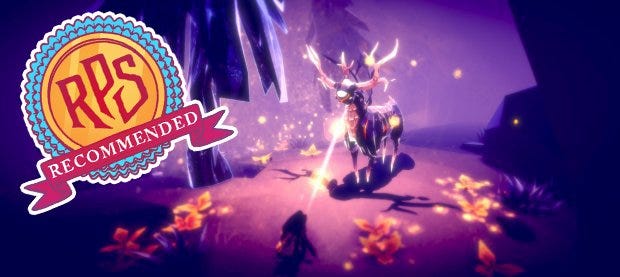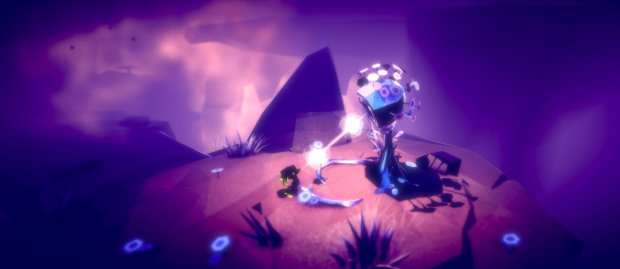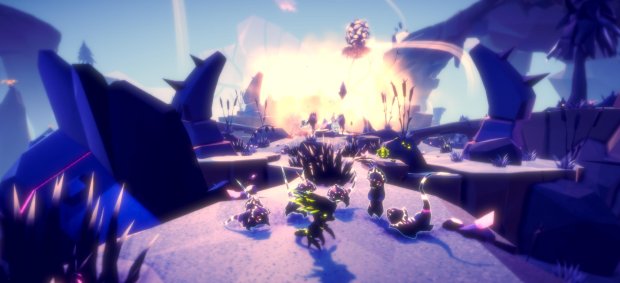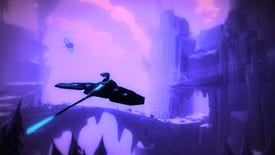Wot I Think: Fe
Feeeeeeeeeling Good
Fe is, I'm so pleased to report, utterly wonderful. I've no idea how to say it, whether it's "Fee", "Fey", or maybe even "Iron"? It matters not. It is, perhaps, the most beautiful game I've ever seen. And playing it, swooping, running and leaping about in its world, has been a complete delight. And continues to be, even after I've ostensibly finished it. Here's wot I think.
I wasn't quite sure at the start. Fe is immediately beautiful. Strikingly so, the sort of game where I've felt more like I'm taking pictures of stunning sunsets than screenshots for a review. (It holds the highest acclaim of being the first game to bump Firewatch from my desktop backgrounds since early 2016.) As you move your astoundingly animated creature - part porcupine, part badger, maybe? - through the luscious woodlands and vistas, the atmosphere changes colour around you, creatures teem in its vivid and luscious environments, plants and water shimmer around you. Look, it's bloody gorgeous.
The next thing you'll notice is that movement is a real pleasure too. Your character, let's call him Fe for the sake of trying to make sense of the wordless game's name, scampers and jumps in an immediately gratifying fashion, feeling free and agile from the start. So there you are, there the world is, and... oh.
This was the source of my hesitation. As a consequence of Fe's desire to be open and ambiguous in its presentation, it's also surprisingly directionless in its opening moments. I love freedom and open worlds, but I always feel a bit overwhelmed, almost agoraphobic, when there's not even a given reason for going anywhere. The moment is brief, and soon I found a creature to chase through the countryside, to see where it was going, and then in a moment of unbridled madness, decided I liked the look of something that caught my eye in a different direction, and diverged. And from that moment on I understood that playing Fe was going to be that splendid combination of knowing there was something I was supposed to be doing, and enjoying not quite getting around to it yet.
Fe is about exploring, discovering, and singing. Singing! Your little guy, with a squeeze of a controller trigger, lets out a sort of caterwauling sound, louder and more intense the harder you squeeze. Experiment with it and you soon learn you can use it to communicate with flora and fauna in the world. And how is simply wonderful. By the pressure you put on the trigger, you tune in to the correct frequency to successfully talk to an animal or plant, until eventually orbs of light are transferred between you. With a plant this might trigger it to unleash spores that create sproingy platforms. With an animal, it befriends them and allows you to work together with the creatures of this Nordic idyll. Communicate with an adult creature - ie. a giant thing - and it'll teach you its own language, adding to Fe's vocabulary and allowing her to interact further, communicate with more plants, and take advantage of their boosts to her movement.
Fe eventually explains that your next goal is marked on its map, and then straight away tells you it can be switched off if you don't want to know. I left it on, because it's a big world and I felt happy meandering toward the intended direction in my own time. As you follow its trail, you expand your sung vocabulary, and as such your range of abilities. And in this sense there's a little bit of metroidvania to the third-person action world. However, not in the sense that you constantly find walls you can't get past yet - but rather you realise that if you go back to where you've been before, there'll now be so much more to do.
The other thing that confused me at first was my search for the attack button. There isn't one. And you aren't going to get one. Fe isn't a world without threat - in fact, for some sections there's enormous danger. But you aren't going to whack it to make it go away. The Silent Ones (a name I only learned from reading the game's sales blurb - it's not mentioned in the game) are a group of creatures who seem to be up to some sort of dreadful business, capturing creatures and plants in their organic cages, and trying to corrupt some of the world's most beautiful creatures. You, as you potter about, almost inadvertently thwart their malevolent machinations, but will need to keep out of their line of sight to stay safe. That's relatively simple, with bushes to hide in, but offers a welcome stealth-aspect that only occasionally breaks up the free roaming.
It's a simple game, it isn't going to offer challenge, but that's rather the point of its existence. It's something to enjoy being within, and when something's as sumptuous as this, that's enough.
This is all going somewhere, the ambiguous story further hinted at by occasional peculiar playable flashbacks, where you are seemingly seeing through the eyes of one of the Silent Ones. To be honest, while I thought I was getting to grips with what it was all about, by the time I'd finished the scripted events and the credits rolled (over the top of the game as I carried on playing, very clearly flagging that it intended me to keep enjoying and exploring the world, finding all the very many undiscovered collectibles), I realised I hadn't the faintest idea what had happened. It's notable that this really didn't matter much. This is a game much more about reveling in the intense beauty and ridiculous pleasure of movement than worrying too much about anyone's motivations.
And indeed it's a game about relationships. The way you bond with creatures, gain trust, find symbiotic advantages, is completely compelling. That the absence of combat feels like no absence at all is also testament to just how superbly complete it all feels, how rewarding is its exploration.
That's all escalated further by the music. Haunting and perfect cello, viola and violin create a joyous score, shifting tone and pace depending upon the environment and circumstances. It's quite the thing to walk between two cliffs, and see the world around you almost imperceptibly shift from hues of blue and purple to pink and yellow, while the music soars about you.
This is Fe throughout, a truly beautiful game, uplifting, gorgeous and alive.
Fe is out today on Windows, for £18, via Origin only.
Post Script: All of this makes EA's decision to pointlessly and inanely restrict this game to their barely used and less wanted bespoke online store, Origin, an act of self-sabotage and vandalism. This is the sort of game that would thrive on broadly used services like Steam, GOG, Humble and Itch, where audiences are likely to explore for new games, receive recommendations, and see what their friends are playing. Precisely seven people worldwide use Origin in this way, most begrudgingly opening it only when they want to play the previous game EA mindlessly undermined by restricting it to their vanity store.
This allows EA to charge utterly disgraceful amounts for their games on PC, like £55 for something as bland as Need For Speed Payback, removing any possibility of market competition or just the plain awkwardness of their mediocre games costing £20 more than everything else on Steam. But when it comes to a smaller, independent, relatively unknown (Zombie Vikings? Anyone?) game developer like Zoink!, it ensures the game's massive disadvantage on PC. Not only that they're charging £17 for a game that would fly off of Steam/Humble at a tenner, but putting it on a store that is never browsed.
Fortunately for Fe's sake, it's receiving a cross-platform release, and hopefully will find its audience through PlayStation, Xbox and Switch. But the PC build will receive a fraction of the sales it deserves, at the hands of the hubris of its publisher.



















